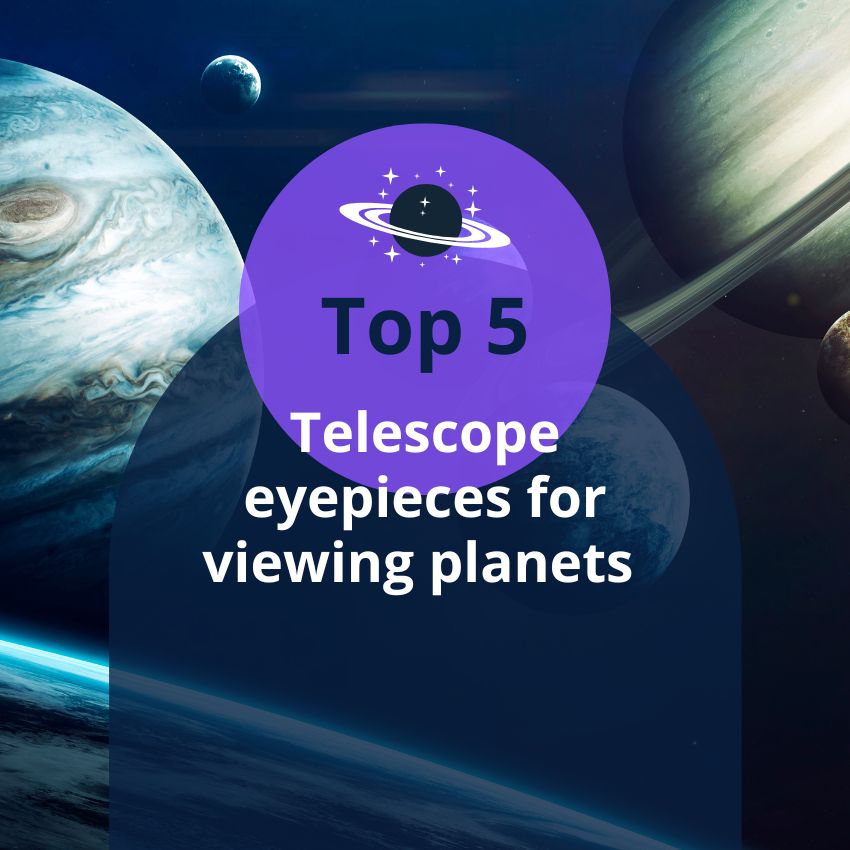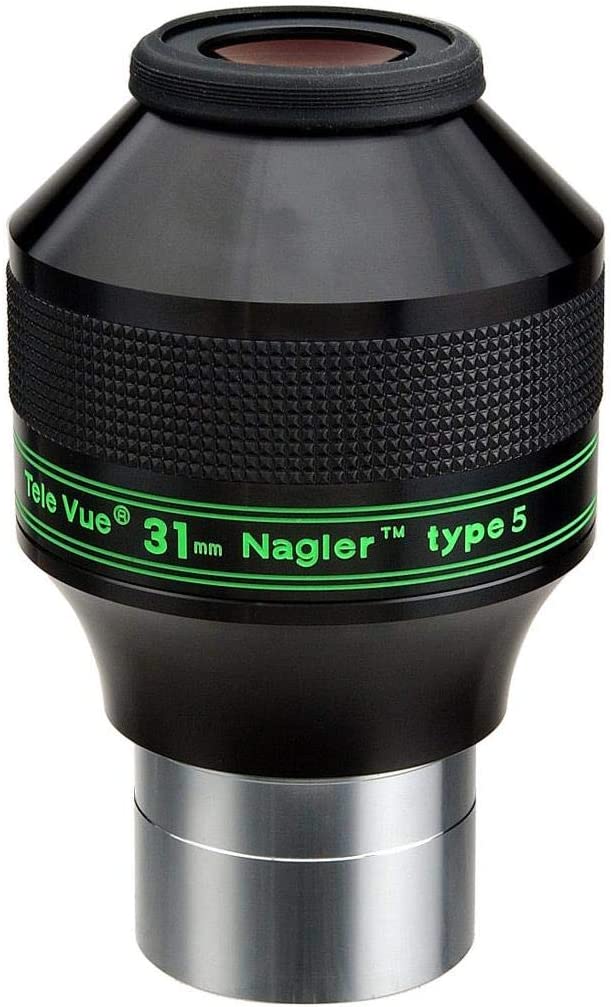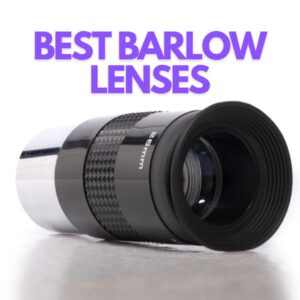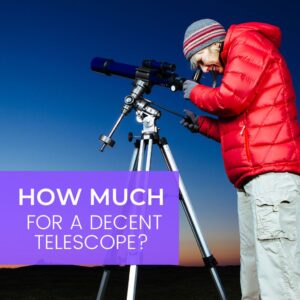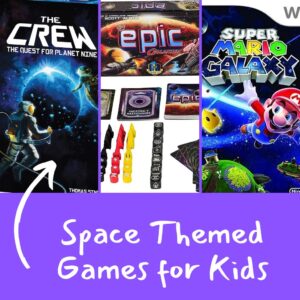This site contains affiliate links to products. I may receive a commission for purchases made through these links.
For exploring high-powered views of different planets, you’ll need multiple eyepieces to complement your telescope’s work.
To view planets, you must consider eyepieces that maximize resolution, contrast, and details. The five best telescope eyepieces for viewing planets include the Baader Hyperion, the Vixen Lanthanum, the William Optics Super Wide Angle, William Optics Zoom, and Pentax XW.
In this guide, we share the best telescope eyepieces for studying planets. Also, we’ll discuss some of the features you should consider, types of eyepieces, and how to choose the right eyepiece for your needs.
1. Baader Hyperion
The Baader Hyperion eyepieces come in seven focal lengths, including 24mm, 21mm, 17mm, 13mm, 10mm, 8mm, 5mm, and 3.5mm. Baader has discontinued the 3.5mm focal length variant due to low demand.
The standard Baader Hyperion design provides quality wide-field viewing at a relatively cheap price point. They work well with 1.25 and 2-inch focusers without needing adapters.
Each eyepiece has an eye relief of 20mm, except the 24mm focal length variant with 17mm. They’re all fully multi-coated and have an AFOV of 68 degrees, except the 21mm variant with 65 degrees.
Baader Hyperion eyepieces are most suitable for slower f/ratio telescopes from f/6 and up. Of the lot, the Baader Hyperion 17mm eyepiece offers the best performance, offering the best off-axis sharpness. The 5mm is a close second.
2. Vixen Lanthanum
The Vixen Lanthanum eyepiece set is another wide-angle design. Astronomers prefer them over other wide-field options due to their being lightweight. They are also known for their long eye relief of 20mm and as much as 30mm on the 50mm focal length variant.
Their fully multi-coated glass surface gives enhanced contrast while viewing planets. You can get this eyepiece in focal lengths as low as 2.5mm and as high as 50mm.
Most eyepieces in the set have a 42-degree AFOV except the 42mm and 30mm variants with 42 degrees and 60 degrees, respectively.
Lanthanums offer sharp, contrasty planetary viewing. They are also known for their superb edge performance. You can get the Vixen Lanthanum eyepieces starting at around $100.
3. William Optics MegaWide
The super or mega wide eyepiece design from William Optics comes in six focal lengths, including 40mm, 33mm, 25mm, 20mm, 15mm, and 9mm.
The mega-wide design has an AFOV of 72 degrees. They’re all fully multi-coated to prevent light loss and have blackened lens edges to give excellent contrast.
The eye relief is reasonable on the smaller focal length models. You’ll enjoy long eye relief of 15mm and above from the 20mm model upwards. The William Optics 40mm super wide angle eyepieces have an eye relief of 28 mm.
With its low power and wide angle, you can easily find planetary objects. However, expect some slight flaring when viewing brighter bodies.
4. Pentax XW
Initially, the eyepieces in the Pentax XW design were of focal lengths between 3.5 to 23mm. Later, the manufacturer added XW30-R and XW40-R to the range. The Pentax XW eyepieces have an AFOV of 70 degrees and a generous 20mm eye relief.
One of the typical issues with wide-field eyepieces is that you do not get edge-to-edge sharpness in your field of view. The Pentax XW eyepiece set is an exception to this “rule.” It also scores highly on the contrast scale, enabling it to resolve images cleanly.
One thing to note is that this set performs better when paired with telescopes with longer focal ratios. With faster instruments, you may experience some form of mild field curvature.
The Pentax XW10mm eyepiece has the best performance of this set and performs reasonably better than the rest when paired with a fast scope.
5. William Optics Zoom
The William Optics (WO) Zoom eyepiece has an adjustable focal length between 7.5 and 22.5mm and an eye relief of 20mm. Its AFOV ranges between 42 and 66 degrees. It is fully multi-coated, internally baffled, and has all its internal spacers and lens’ edges blackened to increase contrast.
From experience, the WO Zoom performs well across multiple telescopes. Whether using the Celestron C8 SCT, the WO Zenithtar 80 FD, or the Stellarvue SV50 finder scope, WO Zoom has incredible optical quality across the board. You’re sure of edge-to-edge sharpness and little to no reflection or distortions.
Some of the drawbacks of this model include being a tad heavy and having a narrow field of view at the lowest magnification. So you have to be wary of balance issues.
What features of telescope eyepieces are important if you aim to observe planets?
Telescope eyepieces have different features. However, there are three features that we consider the most important if your goal is to observe planets. These are:
field of view, eye relief, and barrel size.
- Field of view: Field of view is an angular metric that describes how much of a planetary body you can see when an eyepiece has been paired with a telescope. A great field of view for a telescope eyepiece to view planets typically falls within the range of 40 to 60 degrees. This field of view allows for a comfortable and immersive viewing experience while observing planets, offering a good balance between magnification and the ability to track planetary movements.
- Eye relief: This metric refers to the gap between your eyes and the eyepiece. You measure this distance from the point where you can see the entire field of view. Ideally, this feature should be relatively long. When it’s short, your viewing experience is uncomfortable. If you wear glasses, it’s even worse. You’ll also need a minimum of 15mm eye relief to enjoy your stargazing experience.
- Barrel size and compatibility: Barrel size determines if the telescope eyepiece you purchased will work with your telescope focuser. You’ll likely encounter three barrel sizes: 1.25 inches, 2 inches, and 0.965 inches. The 0.965-inch eyepieces are mostly only popular in Japan. If your telescope has a 1.25-inch focuser, only a 1.25-inch eyepiece would work. However, with the help of an adaptor, you can use a 2-inch eyepiece with a telescope with a 1.25-inch focuser.
You may also like:
Types of telescope eyepieces and their respective capabilities for observing planets
There are different kinds of eyepieces with varying degrees of sophistication. Obviously, more sophistication translates to better results when observing deep-sky objects. The different types of eyepieces include Plössl, Erfle, Orthoscopic, Kellner, Wide-field, and Zoom eyepieces.
Plössl eyepiece for observing planets
Each Plössl eyepiece consists of two concave lenses and two convex lenses. The two groups of lenses together form what is called a doublet lens.
Plössl eyepieces didn’t gain popularity till the 1980s. They now practically come with most telescopes these days. These eyepieces are popular because of the wide apparent field of view they have.
A standard Plössl eyepiece has an AFOV between 50° and 58°. This wide AFOV is advantageous for viewing planets and is one of the reasons for its rise in popularity. The prices for Plössl eyepieces may be relatively high, though.
Plössl eyepieces also have short eye relief and short focal length. This feature can make them uncomfortable to use for people with eyeglasses.
The Meade Instruments Super Plössl eyepiece is a super affordable option to buy, especially if you’re new to astronomy.
Erfle eyepiece for observing planets
An Erfle eyepiece comprises five or six lenses in three groups, with at least two doublets. The last lens is either a singlet or doublet.
Erfle eyepieces have excellent eye relief and a wide apparent field of view. Their AFOV ranges from 65° to 70° and is popular with wide-field designs.
They are one of the most expensive eyepiece designs, alongside Plössl and Orthoscopic. Despite being in the same price range, Orthoscopic and Plössl designs have superior sharpness and contrast to Erfle eyepieces.
Erfle eyepieces are perfect for viewing open clusters and star fields. The typical focal lengths for this eyepiece design range from 18mm to 32mm.
The GSO 2 inches SuperView 30mm eyepiece is perhaps one of the best wide-field eyepieces that cost less than $100.
Orthoscopic eyepieces for observing planets
An Orthoscopic (Orthos) eyepiece has four lenses asymmetrically spaced in two groups. They have good eye relief but a limited AFOV. The AFOV for Orthos range from 40° and 45°, and their focal length ranges from 4mm to 25mm.
Orthos have outstanding sharpness and limited field curvature and astigmatism. This feature makes them great for viewing bright sky objects with plenty of detail. As such, Orthos is exceptional for lunar and planetary viewing.
The Baader Planetarium Classic Orthos are affordable and good entry eyepieces for newbies.
Kellner eyepieces for observing planets
A Kellner eyepiece uses three lenses in two groups. This setup helps reduce the risks of chromatic aberration, where all the colors are not focused where they should be.
You’ll still observe some color errors when observing bright planetary objects like Venus and Jupiter.
The AFOV for Kellner eyepieces averages around 40°. Compared to other eyepieces, they have average eye relief.
This design also has a moderate sharpness with some visible field curvature and astigmatism. While they come in other focal lengths, your best bet is to stick with Kellner eyepieces in the range of 16mm to 26mm.
The MEOPTEX Kellner 26mm eyepiece at a price point of less than $50 provides great quality for amateur observers, especially kids.
You may also like: The Best Telescope For Kids To Spark an Interest in Astronomy
Wide-field eyepieces for observing planets
As the name suggests, wide-field eyepieces enable observers to enjoy a broader stretch of the sky. This ability is helpful when searching for faint deep sky objects or those that don’t fit within a regular telescope eyepiece at high magnification.
Ideally, they should come in a 2-inch barrel because the other alternative – 1.25-inch barrel – will limit the field of view. What you gain in a wide field of view comes at the expense of crisp and sharp image quality.
It’s not uncommon to find wide-field eyepieces exhibiting some form of field curvature. You’re likely to experience some form of distortion too. Overall, expect some tradeoffs in different forms when you’re working with a wider field of view.
The Meade 5000 24mm UHD wide-field eyepiece is one of the best performers if your budget is in the 250-$300 range.
If you want something cheaper but with great value, you can’t go wrong with the Celestron 93431 Luminos 10mm Eyepiece.
You may also like: Is A Cheap Telescope Worth It?
Zoom eyepieces for observing planets
When observing with a Zoom eyepiece, you can adjust its focal length to increase or decrease magnification. This way, you can zoom in or out to see more details or get a full view of an object.
One of the advantages of these eyepieces is that they can replace the job done by multiple regular eyepieces. You can adjust most from either 7mm to 21mm or 8mm to 24mm focal lengths.
You also won’t need to change eyepieces while looking at planetary bodies because you want to change the magnification. If you now pair a Zoom eyepiece with a Barlow lens, you can double or triple the magnification.
The Baader 8-24mm Hyperion Universal Mark IV Zoom eyepiece is arguably the best of the Zoom eyepieces bunch.
You may also like: The Best Barlow Lens For Any Telescope (Buying Guide)
How does eyepiece quality affect the ability to see details on planets?
High-quality eyepieces are fully multi-coated and have their lenses’ edges blackened. They also combine multiple optical elements, quality lenses, and complex configurations to increase magnification while reducing optical errors. These features give premium eyepieces better resolution, excellent contrast, and sharp images.
If you want the best experience observing planetary bodies with limited or no optical aberrations, your best bet is to shop for higher quality from the onset.
Budget considerations matter, but you can balance penny-pinching and prioritizing quality. In the long run, you’ll likely fall back to buying quality, anyway, as you gain more experience watching planets.
So, what does a premium telescope eyepiece give you over inferior ones?
Better resolution
The farther you are from someone, the harder it is to see the details on their face. You can’t for sure describe their facial features in detail. However, the details on their face become more apparent the closer you move to them.
The same principles apply when you use higher quality eyepieces. They move you closer to deep sky objects to get a clearer picture.
High-quality eyepieces combine multiple optical elements, complex designs, quality lenses, and careful configuration to elevate features such as magnification while reducing aberrations. Thus, allowing you to see more details.
Better contrast and quality coatings
Fantastic contrast helps you see the details on a planet’s surface. You can see dim planetary objects against the sky’s background. Good contrast and good resolution are indispensable when viewing planets and the moon.
To make balanced eyepieces, most telescope manufacturers have to make tradeoffs. To improve some features, manufacturers add more glasses to eyepiece designs.
More glasses increase the chances of light loss from dispersion and reflections. These twin issues reduce contrast.
Manufacturers use coatings to mitigate the effects of light loss. The more of the eyepiece surface that is coated, the better the performance. The goal is to reduce light loss.
Premium eyepieces are coated at least once. Manufacturers call this “fully coated.” Eyepieces with coatings on the outer glass surfaces are known as “multi-coated.”
“Fully multi-coated” eyepieces have all their surfaces coated at least twice. Multi and fully multi-coated designs offer superior performance over just fully-coated ones.
If you have cash to splurge, the Televue 31mm Nagler Type 5 eyepiece is one of the best premium-premium eyepieces you can get. It’s perfect for your wide-field needs.
How to choose the right telescope eyepiece for viewing planets
It is essential to piece together certain information before deciding which eyepiece is right for you. To choose the best eyepiece for viewing planets, you need to consider your personal interests, the level of detail you seek, and your budget.
Personal preference and planetary interests
For small solar system objects like the planets and planetary nebulae, an eyepiece with a small AFOV, short focal length, and fewer optical elements is preferable. These eyepieces offer better contrast and color fidelity for these small objects.
Conversely, large objects like the Milky Way and open star clusters require an eyepiece with a longer focal length and wide AFOV.
The next step is to consider the level of detail you want to see. Are you okay with only seeing the planets’ form or you’re interested in seeing other details?
Again, a high-power eyepiece with a very short focal length is preferable if you want to see more details.
Price of the eyepiece
The last step is to consider your budget. It’s important to note that the level of detail you desire may come at an extra cost. The improved contrast and crispier resolution come with premium eyepieces in the $250-$500 range.
Which telescope eyepiece is best for regular usage?
The four-element Celestron Plössl eyepiece can be considered one of the best for regular usage. If you have a limited budget, you can purchase the 32mm and the 9mm for a start. The 32mm is adequate for wide sky observation, while the 9mm works great for planetary viewing.
The four-element Celestron Plössl eyepiece gives a good balance between affordability and optical performance. You can add a Barlow lens into the mix to extend the functionality of the eyepieces.
This set works well with f/5 and above scopes and the Schmidt Cassegrain Telescope.
What is the best eyepiece for viewing the moon?
You’ll need to use a high-magnification eyepiece with a short focal length and a small apparent field of view to see the moon’s finer details. Some of the best eyepieces that fit this bill include Astromania 6mm Plossl eyepiece, the Orion 8885 5mm eyepiece, and the Tele Vue DeLite 7mm 1.25 inches eyepiece.
On the other hand, if you want to enjoy a wide view of the moon, you may opt for one of the best budget telescope eyepieces like the SVBONY 1.25 inches Telescope Eyepiece.
Are telescope eyepieces universally compatible with all telescopes?
In most cases, you can use any eyepiece in any telescope as long as the barrel size for the eyepiece matches that of the telescope’s focuser.
The barrel size can only be one of 1.25 inches, 2 inches, and 0.965 inches, although the latter is no longer popular.
You may also like: Is SVBONY a Good Brand?
What is magnification in planetary viewing?
The focal length of an eyepiece and that of a telescope determines the magnification you’ll enjoy when observing planets. Magnification determines the type of objects and how much detail you’ll see.
The formula to calculate magnification is below:
Magnification = Telescope’s focal length/eyepiece focal length
High-magnification eyepieces have focal lengths within the range of 2.5 – 8mm. This set is fantastic for viewing planetary and lunar objects.
Eyepieces within the range of 10 – 18mm in length are referred to as medium magnification eyepieces. They are great for observing globular star clusters and some Deep Sky objects that require moderate detail.
Lastly, eyepieces within the range of 20 – 32mm and above length are referred to as low magnification eyepieces. They are good for looking at faint star clusters and nebulae.
It’s important to note that each telescope has a maximum useful magnification. Think of the metric as the limit beyond which increased magnification no longer serves any purpose. You can calculate the maximum useful magnification using the formula below.
Maximum useful magnification = 50 * telescope aperture size in inches
For a 5-inch telescope, your maximum useful magnification would be 250x. Most images you’ll get beyond this magnification will be dim and blurry.
Takeaway: The best telescope eyepieces to amplify your telescope’s powers
Your telescope is as good as the eyepiece you use on it. While premium eyepieces may be a tad on the high side, the sharpness, and resolution you’ll get make this a no-brainer for viewing planets.
Using this guide, you can deduce which eyepiece best serves your needs. You can pick five of the best: the Baader Hyperion, the Vixen Lanthanum, the William Optics Super Wide Angle, William Optics Zoom, and Pentax XW.
Read also:

